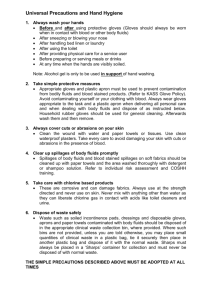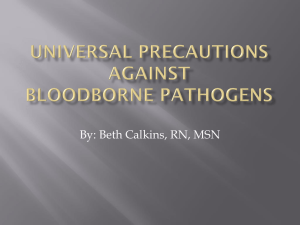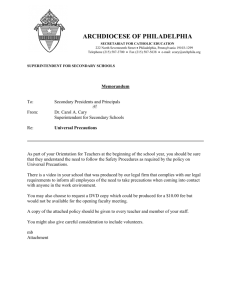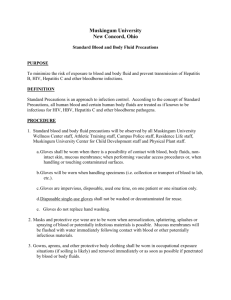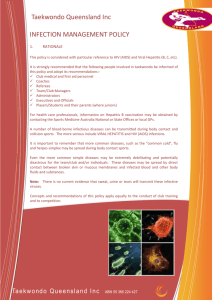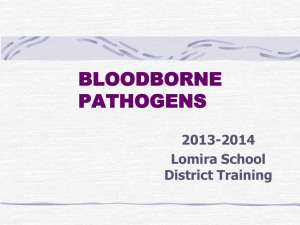BBP QUIZ - Louisburg USD 416
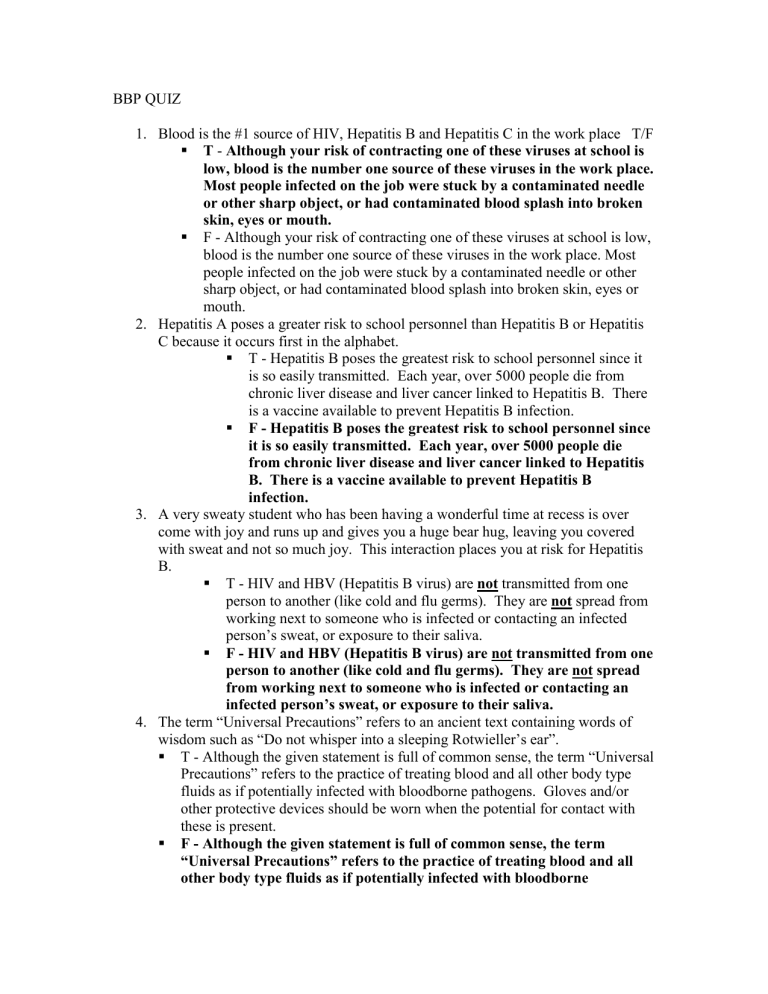
BBP QUIZ
1.
Blood is the #1 source of HIV, Hepatitis B and Hepatitis C in the work place T/F
T - Although your risk of contracting one of these viruses at school is low, blood is the number one source of these viruses in the work place.
Most people infected on the job were stuck by a contaminated needle or other sharp object, or had contaminated blood splash into broken skin, eyes or mouth.
F - Although your risk of contracting one of these viruses at school is low, blood is the number one source of these viruses in the work place. Most people infected on the job were stuck by a contaminated needle or other sharp object, or had contaminated blood splash into broken skin, eyes or mouth.
2.
Hepatitis A poses a greater risk to school personnel than Hepatitis B or Hepatitis
C because it occurs first in the alphabet.
T - Hepatitis B poses the greatest risk to school personnel since it is so easily transmitted. Each year, over 5000 people die from chronic liver disease and liver cancer linked to Hepatitis B. There is a vaccine available to prevent Hepatitis B infection.
F - Hepatitis B poses the greatest risk to school personnel since it is so easily transmitted. Each year, over 5000 people die from chronic liver disease and liver cancer linked to Hepatitis
B. There is a vaccine available to prevent Hepatitis B infection.
3.
A very sweaty student who has been having a wonderful time at recess is over come with joy and runs up and gives you a huge bear hug, leaving you covered with sweat and not so much joy. This interaction places you at risk for Hepatitis
B.
T - HIV and HBV (Hepatitis B virus) are not transmitted from one person to another (like cold and flu germs). They are not spread from working next to someone who is infected or contacting an infected person’s sweat, or exposure to their saliva.
F - HIV and HBV (Hepatitis B virus) are not transmitted from one person to another (like cold and flu germs). They are not spread from working next to someone who is infected or contacting an infected person’s sweat, or exposure to their saliva.
4.
The term “Universal Precautions” refers to an ancient text containing words of wisdom such as “Do not whisper into a sleeping Rotwieller’s ear”.
T - Although the given statement is full of common sense, the term “Universal
Precautions” refers to the practice of treating blood and all other body type fluids as if potentially infected with bloodborne pathogens. Gloves and/or other protective devices should be worn when the potential for contact with these is present.
F - Although the given statement is full of common sense, the term
“Universal Precautions” refers to the practice of treating blood and all other body type fluids as if potentially infected with bloodborne
pathogens. Gloves and/or other protective devices should be worn when the potential for contact with these is present.
5.
Washing your hands after contact with blood or other body fluids is your main protection against contracting an infection or transmitting it to others.
T - Old fashioned, but still the most effective! Wash your hands and other skin surfaces immediately after contact with blood or other body fluids. Wash with a non-abrasive soap and running water for at least 15 seconds. Hand sanitizer may also be used if your hands are not visibly soiled.
F - Old fashioned, but still the most effective! Wash your hands and other skin surfaces immediately after contact with blood or other body fluids. Wash with a non-abrasive soap and running water for at least 15 seconds. Hand sanitizer may also be used if your hands are not visibly soiled.
6.
For minor cuts and scrapes, encouraging victims to administer their own first aid is the best practice.
T - For minor cuts and scrapes, encourage victims to administer their own first aid by applying pressure with gauze to stop the bleeding, washing the area with soap and water and then applying a bandage. If your assistance is needed, please apply a pair of gloves before administering the first aid.
F - For minor cuts and scrapes, encourage victims to administer their own first aid by applying pressure with gauze to stop the bleeding, washing the area with soap and water and then applying a bandage. If your assistance is needed, please apply a pair of gloves before administering the first aid.
7.
The injured athlete who is bleeding should continue play until the quarter/period ends and then seek treatment.
T - An athlete who is injured (or injured student on the playground) should stop play immediately, have the wound cleaned and bandaged securely, and replace any blood soaked clothing before returning to competition (or play).
F - An athlete who is injured (or injured student on the playground) should stop play immediately, have the wound cleaned and bandaged securely, and replace any blood soaked clothing before returning to competition (or play).
8.
Most exposures to blood result in infection.
T - Most exposures to blood do not result in infection. However, if you are exposed, wash the affected area immediately with soap and water. Then report the exposure to your building nurse or administrator so that necessary treatment may begin.
F - Most exposures to blood do not result in infection. However, if you are exposed, wash the affected area immediately with soap and water.
Then report the exposure to your building nurse or administrator so that necessary treatment may begin.
9.
If your gloves become contaminated with blood when helping a student with an injury, you may wash then off after you are finished and save them for the next time you need them.
T - Gloves used for first-aid procedures are made of latex or vinyl and meant for one time use only. After finishing your first-aid task, gloves should be removed immediately. Never touch the outside of the glove with bare skin.
Wash hands with soap and running water as soon as possible.
F - Gloves used for first-aid procedures are made of latex or vinyl and meant for one time use only. After finishing your first-aid task, gloves should be removed immediately. Never touch the outside of the glove with bare skin. Wash hands with soap and running water as soon as possible.
10.
One of the advantages of wearing the annually issued USD 416 name badges is that it will effectively ward off germs and deflect any bloodborne pathogens that come your way.
T - Hand washing, using personal protective equipment (gloves, masks), and following Universal Precautions where you recognize all body fluids as potentially infectious materials, will give you the greatest protection against disease.
F - Hand washing, using personal protective equipment (gloves, masks), and following Universal Precautions where you recognize all body fluids as potentially infectious materials, will give you the greatest protection against disease.
Multiple 9’s is desired
Were then instructed to register results

